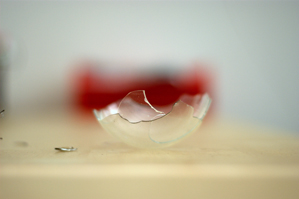The life cycle of a lightbulb

 I have now switched all the light bulbs in my life from incandescents to CFLs — compact fluorescent lights. The initial motivation was cost: while a single CFL bulb is a lot more expensive than an incandescent, it can last 10 to 25 times longer and saves a lot of money in the long run (not to mention the fact that I’m short and don’t like changing light bulbs).
I have now switched all the light bulbs in my life from incandescents to CFLs — compact fluorescent lights. The initial motivation was cost: while a single CFL bulb is a lot more expensive than an incandescent, it can last 10 to 25 times longer and saves a lot of money in the long run (not to mention the fact that I’m short and don’t like changing light bulbs).
This is a trade-off: more money now for less money later. Civil and environmental engineering professor Matthew Eckelman devotes his life to tradeoffs, not just of the financial sort, but of the entire life cycle sort.
When we talk about “going green” and being “sustainable,” it’s not as simple as buying an organic cotton tee shirt or switching from incandescents to CFLs. We have to look at the bigger picture in its entirety, said Eckelman, who joined the Northeastern faculty in January.
“The models I use are environmental life cycle assessment models,” said Eckelman. “Our overall goal is to provide policy- and consumer-relevant information about the environmental impacts of different products and materials.”
In the late 2000s, CFLs were a big thing, Eckelman said. Walmart sold over 100 million bulbs in a single year. As the bulbs became more prevalent, people began to learn that each one contained about a bit less than 5 mg of mercury — a toxic chemical we’ve all been warned about again and again. That’s 675 kg of mercury from Walmart alone in one year. Clearly these things must be bad for the environment…right?
Well, the story isn’t that simple. As a graduate student at Yale University, Eckelman published a study showing how complicated it really is. “When you trade out an incandescent for a fluorescent bulb,” said Eckelman, “you introduce mercury in the bulb. On the other hand, you use less energy. The largest source of mercury emissions in this country is coal fired power plants.”
Using a computational modeling approach, Eckelman and his team analyzed all 50 states and 130 countries, looking at the energy use savings of CFLs, the characteristics of local electric power and CFL recycling rates in every jurisdiction for which they had data.
“What we found is that it depends on where you are,” he said. In California, for example, it doesn’t make sense to use CFLs from a mercury perspective, because California doesn’t have many coal fired power plants. The mercury content introduced in the bulbs outweighs that eliminated by the energy savings.
In China, though, coal-fired power generation is the dominant energy production practice and that (at least at the time of the study), very few facilities had pollution control equipment that captured mercury, so emissions there were very high.
Then again, the CFLs used in china have a higher mercury content than here and California imports a lot of its power from Nevada, which does use coal plants. “It’s always a tradeoff one way or another,” said Eckelman. He uses modeling to understand and quantify the effects of those trade offs. His work can then help consumers like you and I make better buying decisions and inform policy makers about the big picture.
The locational dependence of the CFL analysis is not unique: “This is a general feature of a lot of these life cycle studies,” said Eckelman. So informing and engaging local governments about their particular situation is extremely important.
Photo: kevgee, “Broken Lightbulb II” February 7, 2009 via Flickr. Creative Commons attribution.




